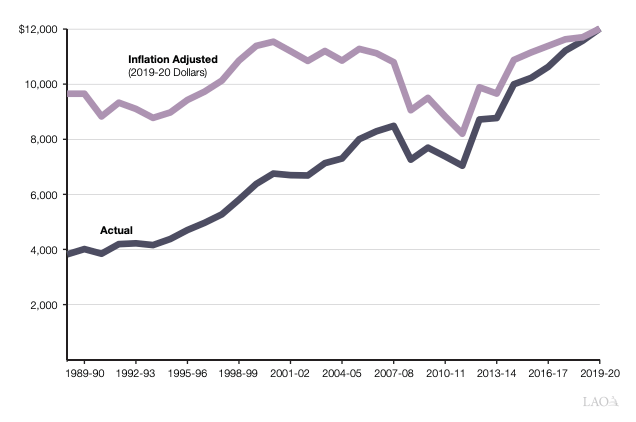Commit Significant New Federal Funds to Support Schools

Rough Road Ahead
On present course and speed, when summer begins schools will just cease — with no real plan in place. That amounts to a risky all-in bet that the virus will already have been swiftly contained, that it's OK for kids to advance to the next grade, and that it's safe to expect that kids will shelter in place this summer with nothing to do.
Then, after summer, the public education system is supposed to just resume operation. Without added additional funding, that's not plausible, either.
It gets worse. The federal CARES Act, passed quickly in response to the pandemic, does not address the needs of education in a serious way. Unless decisive actions are taken promptly the harm will last for years. You know which kids will be hurt most — the ones already behind.
An army of parents and public servants stands determined to protect kids, if they know what to do. Better policies could and should be passed, pronto. Here we offer five, starting with swift action to extend the school year.
1) Plan for the Summer. Don't Wait.
It has become increasingly likely that closures related to the pandemic will stretch onward into the summer, even if shelter in place rules are relaxed. The writing is on the wall. The California State PTA has canceled its state convention. Many colleges have already canceled their summer sessions or announced that they will be online-only.
Will bored kids really stay home? Summer school has never been this important.
In normal times, people who run summer programs for children would be recruiting and actively planning right now. Few are doing that now, because the questions are too large to permit investing in them. Will social distancing still be the rule? Will summer programs have to be online, like schools? Will there be funding for them? Can families pay? Will kids be expected to stay home, bored out of their minds — and if so, what will happen? What will families do? What should we want them to do?
Summer school has always been a twine-and-chewing-gum thing. It only exists where people somehow cobble the money together to make it happen. It certainly isn't universal, like regular school.
The most obvious and quick solution for this school year would be to extend it, significantly. A lot of time has been lost in schools — some are talking about this as a lost year. With swift commitment of federal funds, schools could remain in operation. Perhaps the lost learning could be avoided. Alternatively, districts could be funded to continue operations as creative online summer programs, with the goal of ensuring that every student is signed up for at least something. It doesn't have to be mandatory. It doesn't have to cover content in the standards. It doesn't have to be conventionally tested. Classes don't have to be of uniform size, or have homework, or be graded. TV can play a role, too.
At least as a contingency, state governments and county offices of education might want to consider this: What would you do with a special apportionment that would enable school to operate this summer, online, at massive scale? There's not really a wrong answer to this question. The core purpose, after all, would be to help students and families remain home, stay healthy, remain engaged, and perhaps at least not fall further behind.
2) Provide Sufficient Emergency Federal Funding to Sustain Schools in the Coming Year
Congress quickly passed a $2 trillion package in response to COVID-19 (the CARES Act). But the measure includes very little to sustain K-12 public schools. It obligates states that accept funds to promise to maintain their funding effort at the average of the prior three years, but without funds this is wishful thinking. It contains just $13.5 billion nationwide specifically to support high-need K-12 schools, plus an additional $3 billion for governors to assist K-12 and higher education. It offers virtually no help for internet services or devices through the E-rate program.
The CARES Act contains only budget dust for education.
The California Legislative Analyst Office estimates that California will receive an amount in the neighborhood of $1.6 billion for all of K-12 education. This is budget dust — less than 1% of the total CARES package, and on the order of less than $500 per high-need student. It's far too little to help states sustain schools in a pandemic.
How much funding will actually be needed to sustain public K-12 education? History should be a guide. The market tumble of 2008 was a disaster for public education. It took seven long years for public education funding per student in California to recover to pre-recession levels. But it would have been much worse without federal support.
 California funding per student tanked in the last recession. It took seven years to recover.
California funding per student tanked in the last recession. It took seven years to recover. Congress took timely action in 2009 to create the State Fiscal Stabilization Fund, which helped sustain school district budgets and ward off even deeper disruption in the education of children. The 2009 Stimulus package in response to the Great Recession provided $48.6 billion for education. The impact of the pandemic on schools seems certain to be greater than the impact of a market dip.
Creating a stabilization fund in time of crisis is something that states cannot do for themselves. Deficit spending is uniquely a function of the federal government. As in virtually every state, California's constitution requires a balanced budget. The remedy needs to be of the same scale as the malady, and that means federal action.
3) Fully Fund IDEA
One straightforward way the federal government could quickly and efficiently inject support into the school system would be to add funding for special education. The federal Individuals with Disabilities in Education Act (IDEA) obligates public schools to provide special education services to all students who need them. The federal government is already in arrears; the law set a target that the federal budget would provide 40% of the cost of these services; in practice it has covered only about 15%. Providing federal funds with the express purpose of rebalancing special education might be a straightforward way to support schools — and remind districts that they have an obligation to serve all students, even in hard times.
4) Provide More and Better Food for Kids
Food insecurity is a major issue made significantly worse in the pandemic. California’s relentlessly high cost of living means that federal eligibility criteria do not capture the real needs of our students. Likewise, federal reimbursement rates do not account for the real cost of operating school meal programs in California.
School districts are already in the business of deploying federal funds to feed children, and generally have excellent connections with regional nonprofit food pantries. Federal funds could be quickly provided to schools through existing channels with a mandate to ensure that every family with children has access to ample, nutritious food. The CARES Act includes some money for this purpose, but not enough.
5) Fix the Digital Divide
The digital divide has been a glaring issue for years. Covid-19 has made it obvious that the job is not done, and that fixing it is not optional. The CARES act provides for waivers that allow districts to redirect their federal funds to pay for digital needs, but does not set aside significant new funds for it. In order to provide all children with access to education during a shelter-in-place order, each child needs a decent personal computing device and effective access to the internet where they live. "Go to a library" or "use your phone" isn't a good enough answer anymore.
Past generations tackled harder challenges like providing universal access to roads, electricity, clean water, sanitation, vaccination, schools, television and telecommunication. These things don't have to be free, but they do have to be universal. All families need to be able to access distance learning not just in theory but every day.
What To Do Next
In order for the right things to happen, some swift and purposeful conversations need to happen right now between congressional leaders, state legislative leaders, municipal leaders and school system leaders. Normally, it's rare for these people even to attend the same meetings. But these are not normal times. PTAs and other community leaders can play a powerful role as conveners and advocates. The suggestions above are just a starting place: what can we do to solve this? There really isn't a lot of time.
If you feel frustrated and helpless, there are actually concrete things you can do to help. Education organizations are starting to band together to call for federal support. Legislators need to hear from constituents like you about the need to sustain education in this critical time. Phone calls and messages matter. Is your PTA or parent association talking about these issues? Are student leaders being invited? They need to be in the conversation anyway, right?
What are you and your parent association doing to make sure the needs of children are met? Let us know.
Co-written by Carol and Jeff
Updated April 24, 2020
Tags on this post
Achievement gap Budgets Special ed Summer Technology Federal PandemicAll Tags
A-G requirements Absences Accountability Accreditation Achievement gap Administrators After school Algebra API Arts Assessment At-risk students Attendance Beacon links Bilingual education Bonds Brain Brown Act Budgets Bullying Burbank Business Career Carol Dweck Categorical funds Catholic schools Certification CHAMP Change Character Education Chart Charter schools Civics Class size CMOs Collective bargaining College Common core Community schools Contest Continuous Improvement Cost of education Counselors Creativity Crossword CSBA CTA Dashboard Data Dialogue District boundaries Districts Diversity Drawing DREAM Act Dyslexia EACH Early childhood Economic growth EdPrezi EdSource EdTech Education foundations Effort Election English learners Equity ESSA Ethnic studies Ethnic studies Evaluation rubric Expanded Learning Facilities Fake News Federal Federal policy Funding Gifted Graduation rates Grit Health Help Wanted History Home schools Homeless students Homework Hours of opportunity Humanities Independence Day Indignation Infrastructure Initiatives International Jargon Khan Academy Kindergarten LCAP LCFF Leaderboard Leadership Learning Litigation Lobbyists Local control Local funding Local governance Lottery Magnet schools Map Math Media Mental Health Mindfulness Mindset Myth Myths NAEP National comparisons NCLB Nutrition Pandemic Parcel taxes Parent Engagement Parent Leader Guide Parents peanut butter Pedagogy Pensions personalized Philanthropy PISA Planning Policy Politics population Poverty Preschool Prezi Private schools Prize Project-based learning Prop 13 Prop 98 Property taxes PTA Purpose of education puzzle Quality Race Rating Schools Reading Recruiting teachers Reform Religious education Religious schools Research Retaining teachers Rigor School board School choice School Climate School Closures Science Serrano vs Priest Sex Ed Site Map Sleep Social-emotional learning Song Special ed Spending SPSA Standards Strike STRS Student motivation Student voice Success Suicide Summer Superintendent Suspensions Talent Teacher pay Teacher shortage Teachers Technology Technology in education Template Test scores Tests Time in school Time on task Trump Undocumented Unions Universal education Vaccination Values Vaping Video Volunteering Volunteers Vote Vouchers Winners Year in ReviewSharing is caring!
Password Reset
Search all lesson and blog content here.
Login with Email
We will send your Login Link to your email
address. Click on the link and you will be
logged into Ed100. No more passwords to
remember!














Questions & Comments
To comment or reply, please sign in .
jroubanis April 14, 2020 at 9:41 am
• Emergency Funding Directly to States to Support Local Education Agencies;
• Support for Federal Categorical Programs;
• Emergency Funding for Technology for Remote Learning;
• Infrastructure Funding Must Include Explicit Support for Schools; and
• Recognize School Districts As Employers to include public employers in Payroll Tax Credit.
Derby April 10, 2020 at 12:07 pm
Jeff Camp April 8, 2020 at 12:53 pm